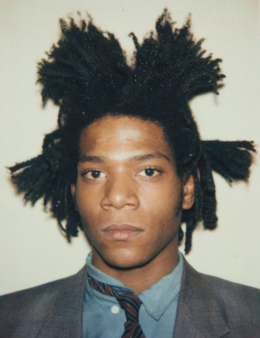c) Jean-Michel Basquiat
Jean-Michel Basquiat, a native of Brooklyn, New York, emerged as a groundbreaking figure in the art world during the late 1970s and early 1980s. He is celebrated for his unique ability to blend street art with the realms of fine art, creating a new and dynamic form of artistic expression.
Basquiat started his artistic journey as a graffiti artist under the pseudonym “SAMO©,” making his mark on the streets of New York City. His graffiti was not just visually striking but also rich in social commentary, often touching on themes of race, class, and the complexities of society. This phase of his career set the tone for his later work, characterized by a raw, expressive style that was both powerful and provocative.
Transitioning from street art to galleries, Basquiat’s work continued to garner attention and acclaim. His art was distinguished by vibrant, chaotic compositions that combined words, symbols, and figures. He often integrated elements of his Caribbean heritage, urban life, and a range of historical and contemporary cultural references.
Basquiat’s rise in the art world was meteoric, and he quickly became one of the most celebrated artists of his time. His collaborations with other artists, notably Andy Warhol, further amplified his influence and standing in the art community.
Despite his tragically short career, ending with his death in 1988 at the age of 27, Basquiat’s legacy endures. His work has continued to influence a wide array of artists across different mediums and has become an integral part of popular culture. His impact is seen not just in the art world but also in fashion, music, and film, making him one of the most enduring and influential artists of his generation. Jean-Michel Basquiat’s contribution to art continues to be celebrated for its vibrancy, relevance, and raw emotional power.

